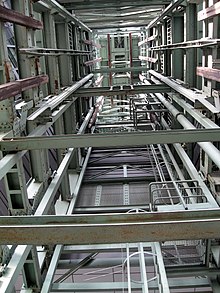A line
A one-stroke is a horizontal installation in a duct which is made of wood or steel and in wells is incorporated. Lines serve to attach the guide rails and to subdivide the shaft disc into individual strands. They do not serve to support the mountains or the shaft lining .
Installation in the shaft
Screeds are made in the free cross-section of the shaft between the joints. The distance between the individual lines can be different. The distance may be up to 4.5 meters for wooden lines, and larger distances can be selected for steel lines. The lines are either embedded in the shaft masonry or shifted to consoles. In the case of shafts in which the bucket is moved at speeds of up to four meters per second, the lines can also be attached to the extension segments. When embedding in the shaft wall, the lines must be embedded in the masonry at least 0.15 meters for safety reasons. The requirements for wood coatings are laid down in the DIN 21321 standard. Steel lines must meet the requirements of the DIN EN 10025 series of standards. In the case of steel laths, the wall thickness must be at least eight millimeters. Fastening screws must be made of at least M 16 . Coatings in weather shafts are provided with corrosion protection for better durability. The load-bearing capacity of built-in screeds must be proven mathematically.
Individual evidence
- ^ A b Walter Bischoff , Heinz Bramann, Westfälische Berggewerkschaftskasse Bochum: The small mining dictionary. 7th edition, Verlag Glückauf GmbH, Essen 1988, ISBN 3-7739-0501-7
- ^ Moritz Ferdinand Gätzschmann: Collection of mining expressions. 2nd edition, Verlag von Craz & Gerlach, Freiberg 1881
- ^ Heinrich Veith: German mountain dictionary with evidence. Published by Wilhelm Gottlieb Korn, Breslau 1871
- ↑ Technical requirements for shaft and inclined conveyor systems (TAS). Verlag Hermann Bellmann, Dortmund 2005
